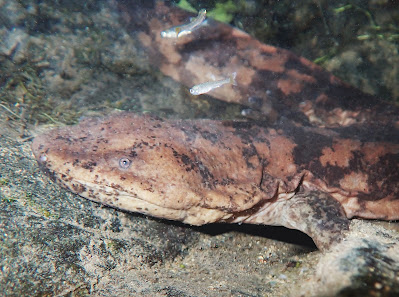 |
| Andrias jiangxiensis Lu, Wang, Chai, Yi, Peng, Murphy, Zhang & Che, in Chai, Lu, Yi, Dai, Weng, ... et Che, 2022. |
Abstract
Effective conservation of threatened biota relies on accurate assessments and scientific guidance. As an unfortunate example, Chinese giant salamanders (Andrias, CGS) remain critically endangered in nature. Misguided conservation efforts, e.g., commercial propagation and releasing of millions of likely non-indigenous or interspecific hybrids, have further compromised conservation initiatives. Limited information on wild populations of CGS poses a significant conservation challenge. Following 18-month long field monitoring, we now report the discovery of a wild population of CGS in a closed nature reserve in Jiangxi Province, China. Genomic assessments reveal its genetic distinctiveness and do not detect genetic admixture with other species. Based on morphological and molecular evidences, we describe this CGS as a new species Andrias jiangxiensis sp. nov. This is the only known species of CGS today with a genetically pure, reproducing, in situ population. This discovery emphasizes the important role that closed nature reserves play in protecting species, and the necessity of integrating long-term field monitoring and genetic assessments. It sets a new pathway for discovering and conserving endangered species, especially for those biotas that are similarly being extirpated by anthropogenic translocations and overexploitation.
Key words: Conservation, Human translocation, Genetic homogenization, Field monitoring, Taxonomy
Andrias jiangxiensis sp. nov. Lu, Wang, Chai, Yi, Peng, Murphy, Zhang, and Che
Diagnosis: Andrias jiangxiensis sp. nov. can be distinguished from its congeners by a combination of the following characters: (1) head length almost equal to width; (2) head and lower jaw relatively smooth, with small tubercles arranged irregularly; (3) lateral neck fold discontinuous with body fold at forelimb insertion; (4) finger III distinctly longer than finger I; and (5) dorsum red-brown or yellow-brown in life, with large, irregular black patches.
Etymology: The specific epithet “jiangxiensis” refers to the type locality of the new species in Jiangxi, China. It denotes the endemicity of the new species to Jiangxi based on our detailed population surveys. We suggest Jiangxi Giant Salamander as its English common name, and 江西大鲵 (Pinyin: Jiāng Xī Dà Ní) as its Chinese common name.
Jing Chai, Chen-Qi Lu, Mu-Rong Yi, Nian-Hua Dai, Xiao-Dong Weng, Ming-Xiao Di, Yong Peng, Yong Tang, Qing-Hua Shan, Kai Wang, Huan-Zhang Liu, Hai-Peng Zhao, Jie-Qiong Jin, Ru-Jun Cao, Ping Lu, Lai-Chun Luo, Robert W. Murphy, Ya-Ping Zhang and Jing Che. 2022. Discovery of A Wild, Genetically Pure Chinese Giant Salamander creates New Conservation Opportunities. Zoological Research. 43(3): 469-480. DOI: 10.24272/j.issn.2095-8137.2022.101





